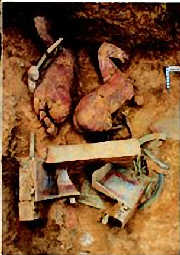 Location: Zhangqiu City in Jinan, East China's Shandong Province
Location: Zhangqiu City in Jinan, East China's Shandong Province
Period:Han Dynasty(206 BC- AD220)
Excavation period: November 23, 2002 to early 2003
A joint team of researchers from the Shandong Provincial Cultural Relics Archeological Research Institute, Jinan City Archeological Research Institute and Zhangqiu City Museum, led by Wang Shougong
 Findings
Findings
In an amazing archaeological discovery last year, three terracotta army pits were unearthed in a Han Dynasty (206BC-AD220) tomb complex on Mount Weishan in Zhangqiu City, Shandong Province.
The excavation team uncovered three attendant pits, over 30 mausoleums and three kilns harvesting a large number of color-painted terracotta chariots, horses and soldiers. All the soldiers and horses were made out of moulds.
The No 1 pit is 9.7 meters long and 1.9 meters wide, and contains 173 painted terracotta soldiers, 56 horses, four chariots and more than 90 shields. Following the burial customs of nobles of the Han Dynasty, the soldiers and chariots were arranged in an outing formation, with the cavalry in the lead, followed by chariots and the infantry. There are 30 lifelike terracotta cavalrymen arranged in six rows. The riders have a dignified disposition, and the crimson-painted horses, are very sturdy looking. The three chariots in the middle are among the biggest ceramic chariots from the Han Dynasty unearthed in China. Eighty foot soldiers are positioned behind, wielding spears and shields. Although slightly smaller than the cavalrymen in front, the foot soldiers also sport a commanding presence. Scattered around the soldiers are instruments used by the honor guards.
